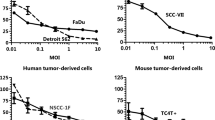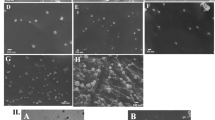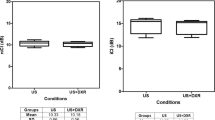Abstract
Low-intensity ultrasound is a useful method to enhance the delivery of drugs to target cells via a range of mechanisms including the transient formation of micropores in the cell membrane, a process known as sonoporation. The effect of ultrasound on oncolytic herpes simplex virus type-1 (HSV-1) infection in oral squamous cell carcinoma (SCC) was examined. Human SCC cell line SAS and oncolytic HSV-1 RH2, which was deficient in the neurovirulent γ134.5 gene and exhibited cell fusion actions, were used. Cells grown in multi-well plates were infected with HSV-1 and exposed to ultrasound in the presence or absence of microbubbles after an adsorption period. The number of plaques was significantly greater than that of the untreated control. SAS cells were inoculated subcutaneously into nude mice and tumors were produced. Tumors were injected with HSV-1 RH2 with or without microbubbles and then exposed to ultrasound through the covering skin. The amount of the virus in tumor tissues 3 days after the injection was higher in tumors treated with HSV-1 RH2 and ultrasound than in tumors treated with RH2 only. The expression of the HSV-1 antigen was also increased by ultrasound and microbubbles. Tumor growth was suppressed with HSV-1 RH2 in combination with ultrasound, especially with microbubbles. These results indicated that ultrasound increased the efficiency of the HSV-1 infection in SAS cells and nude mouse tumors. This method can potentially be useful to enhance the antitumor effects of oncolytic HSV-1 on head and neck cancer treatment.
This is a preview of subscription content, access via your institution
Access options
Subscribe to this journal
Receive 12 print issues and online access
$259.00 per year
only $21.58 per issue
Buy this article
- Purchase on Springer Link
- Instant access to full article PDF
Prices may be subject to local taxes which are calculated during checkout





Similar content being viewed by others
References
Liu BL, Robinson M, Han ZQ, Branston RH, English C, Reay P et al. ICP34.5 deleted herpes simplex virus with enhanced oncolytic, immune stimulating, and anti-tumour properties. Gene Ther 2003; 10: 292–303.
Senzer NN, Kaufman HL, Amatruda T, Nemunaitis M, Reid T, Daniels G et al. Phase II clinical trial of a granulocyte-macrophage colony-stimulating factor-encoding, second-generation oncolytic herpesvirus in patients with unresectable metastatic melanoma. J Clin Oncol 2009; 27: 5763–5771.
Harrington KJ, Hingorani M, Tanay MA, Hickey J, Bhide SA, Clarke PM et al. Phase I/II study of oncolytic HSVGM-CSF in combination with radiotherapy and cisplatin in untreated stage III/IV squamous cell cancer of the head and neck. Clin Cancer Res 2010; 16: 4005–4015.
Carew JF, Kooby DA, Halterman MW, Federoff HJ, Fong Y . Selective infection and cytolysis of human head and neck squamous cell carcinoma with sparing of normal mucosa by cytotoxic herpes simplex virus type 1 (G207). Hum Gene Ther 1999; 10: 1599–1606.
Takaoka H, Takahashi G, Ogawa F, Imai T, Iwai S, Yura Y . A novel fusogenic herpes simplex virus for oncolytic virotherapy of squamous cell carcinoma. Virol J 2011; 8: 294.
Bazan-Peregrino M, Carlisle RC, Purdie L, Seymour LW . Factors influencing retention of adenovirus within tumours following direct intratumoural injection. Gene Ther 2008; 15: 688–694.
Passer BJ, Cheema T, Zhou B, Wakimoto H, Zaupa C, Razmjoo M et al. Identification of the ENT1 antagonists dipyridamole and dilazep as amplifiers of oncolytic herpes simplex virus-1 replication. Cancer Res 2010; 70: 3890–3895.
Tachibana K, Uchida T, Tamura K, Eguchi H, Yamashita N, Ogawa K . Enhanced cytotoxic effect of Ara-C by low intensity ultrasound to HL-60 cells. Cancer Lett 2000; 149: 189–194.
Frenkel V . Ultrasound mediated delivery of drugs and genes to solid tumors. Adv Drug Deliv Rev 2008; 60: 1193–1208.
Maeda H, Tominaga K, Iwanaga K, Nagao F, Habu M, Tsujisawa T et al. Targeted drug delivery system for oral cancer therapy using sonoporation. J Oral Pathol Med 2009; 38: 572–579.
Mo S, Coussios CC, Seymour L, Carlisle R . Ultrasound-enhanced drug delivery for cancer. Expert Opin Drug Deliv 2012; 9: 1525–1538.
Hernot S, Klibanov AL . Microbubbles in ultrasound-triggered drug and gene delivery. Adv Drug Deliv Rev 2008; 60: 1153–1166.
Kowalczuk L, Boudinet M, El Sanharawi M, Touchard E, Naud MC, Saïed A et al. In vivo gene transfer into the ocular ciliary muscle mediated by ultrasound and microbubbles. Ultrasound Med Biol 2011; 37: 1814–1827.
Howard CM, Forsberg F, Minimo C, Liu JB, Merton DA, Claudio PP . Ultrasound guided site specific gene delivery system using adenoviral vectors and commercial ultrasound contrast agents. J Cell Physiol 2006; 209: 413–421.
Li HL, Zheng XZ, Wang HP, Li F, Wu Y, Du LF . Ultrasound-targeted microbubble destruction enhances AAV-mediated gene transfection in human RPE cells in vitro and rat retina in vivo. Gene Ther 2009; 16: 1146–1153.
Bazan-Peregrino M, Rifai B, Carlisle RC, Choi J, Arvanitis CD, Seymour LW et al. Cavitation-enhanced delivery of a replicating oncolytic adenovirus to tumors using focused ultrasound. J Control Release 2013; 169: 40–47.
Carlisle R, Choi J, Bazan-Peregrino M, Laga R, Subr V, Kostka L et al. Enhanced tumor uptake and penetration of virotherapy using polymer stealthing and focused ultrasound. J Natl Cancer Inst 2013; 105: 1701–1710.
Takahashi G, Meshii N, Hamada M, Iwai S, Yura Y . Sequence of a fusogenic herpes simplex virus RH2 for oncolytic virotherapy. J Gen Virol 2013; 94: 726–737.
Kodama T, Tomita Y, Koshiyama K, Blomley MJ . Transfection effect of microbubbles on cells in superposed ultrasound waves and behavior of cavitation bubble. Ultrasound Med Biol 2006; 32: 905–914.
Shintani M, Takahashi G, Hamada M, Okunaga S, Iwai S, Yura Y . Effect of ultrasound on herpes simplex virus infection in cell culture. Virol J 2011; 8: 446.
Hayashi T, Morishita E, Ohtake H, Oda Y, Ohta K, Arahata M et al. Expression of annexin II in human atherosclerotic abdominal aortic aneurysms. Thromb Res 2008; 123: 274–280.
Hilgenfeldt S, Lohse D, Zomack M . Sound scattering and localized heat deposition of pulse-driven microbubbles. J Acoust Soc Am 2000; 107: 3530–3539.
Choi JJ, Carlisle RC, Coviello C, Seymour L, Coussios CC . Non-invasive and real-time passive acoustic mapping of ultrasound-mediated drug delivery. Phys Med Biol 2014; 59: 4861–4877.
Chou J, Kern ER, Whitley RJ, Roizman B . Mapping of herpes simplex virus-1 neurovirulence to γ134.5, a gene nonessential for growth in culture. Science 1990; 250: 1262–1266.
He B, Gross M, Roizman B . The gamma(1) 34.5 protein of herpes simplex virus 1 complexes with protein phosphatase 1 alpha to dephosphorylate the alpha subunit of the eukaryotic translation initiation factor 2 and preclude the shutoff of protein synthesis by double-stranded RNA-activated protein kinase. Proc Natl Acad Sci USA 1997; 94: 843–848.
Smith KD, Mezhir JJ, Bickenbach K, Veerapong J, Charron J, Posner MC et al. Activated MEK suppresses activation of PKR and enables efficient replication and in vivo oncolysis by Deltagamma(1)34.5 mutants of herpes simplex virus 1. J Virol 2006; 80: 110–120.
Pan W, Bodempudi V, Esfandyari T, Farassati F . Utilizing ras signaling pathway to direct selective replication of herpes simplex virus-1. PLoS One 2009; 4: e6514.
Acknowledgements
This study was supported in part by a Grant-in-Aid (No. 24390453) for Scientific Research from the Ministry of Education, Science and Culture of Japan.
Author information
Authors and Affiliations
Corresponding author
Ethics declarations
Competing interests
The authors declare no conflict of interest.
Rights and permissions
About this article
Cite this article
Okunaga, S., Takasu, A., Meshii, N. et al. Ultrasound as a method to enhance antitumor ability of oncolytic herpes simplex virus for head and neck cancer. Cancer Gene Ther 22, 163–168 (2015). https://doi.org/10.1038/cgt.2015.3
Received:
Revised:
Accepted:
Published:
Issue Date:
DOI: https://doi.org/10.1038/cgt.2015.3



